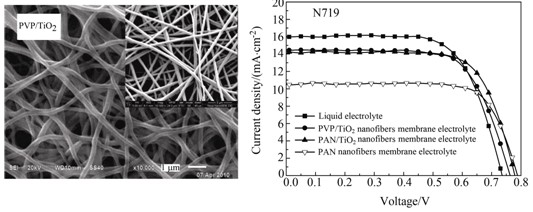| [1] O’Regan, B.; Grätzel, M. Nature 1991, 353, 737.[2] Nazeeruddin, M. K.; Kay, A.; Rodicio, I.; Humpbry-Baker, R.; Müller, E.; Liska, P.; Vlachopoulos, N.; Grätzel, M. J. Am. Chem. Soc. 1993, 115, 6382.[3] Ito, S.; Murakami, T. N.; Comte, P.; Liska, P.; Grätzel, C.; Nazeeruddin, M. K.; Grätzel, M. Thin Solid Films 2008, 516, 4613.[4] Grätzel, M. J. Photochem. Photobiol. A: Chem. 2004, 164, 3.[5] Gao, F.-F.; Wang, Y.; Shi, D.; Zhang, J.; Wang, M.-K.; Jing, X.-Y.; Humphry-Baker, R.; Wang, P.; Zakeeruddin, S. M.; Grätzel, M. J. Am. Chem. Soc. 2008, 130, 10720.[6] Yella, A.; Lee, H. W.; Tsao, H. N.; Yi, C.-Y.; Chandiran, A. K.; Nazeeruddin, M.; Diau, E. W. G.; Yeh, C. Y.; Zakeeruddin, S. M.; Grätzel, M. Science 2011, 334, 629.[7] Meng, Q.-B.; Takahashi, K.; Zhang, X.-T.; Sutanto, I.; Rao, T. N.; Sato, O.; Fujishima, A. Langmuir 2003, 19, 3572.[8] Saito, Y.; Fukuri, N.; Senadeera, R.; Takayuki Kitamura, T.; Wada, Y,; Yanagida, S. Electrochem. Commun. 2004, 6, 71.[9] Wang, H.; Liu, G.-H.; Li, X.; Xiang, P.; Ku, Z.-L.; Rong, Y.-G.; Xu, M.; Liu, L.-F.; Hu, M.; Yang, Y.; Han, H.-W. Energy Environ. Sci. 2011, 4, 2025.[10] Guo, L.; Pan, X.; Dai, S.-Y. Prog. Chem. 2008, 20, 1595. (郭磊, 潘旭, 戴松元, 化学进展, 2008, 20, 1595.)[11] Nogueira, A. F.; Longo, C.; De Paoli, M. A. Coord. Chem. Rev. 2004, 248, 1455.[12] Wang, P.; Zakeeruddin, S. M.; Moser, J. E.; Nazeeruddin, M. K.; Sekiguchi, T.; Grätzel, M. Nat. Mater. 2003, 2, 402.[13] Matsumoto, M.; Miyazaki, H.; Matsuhiro, K.; Kumashiro, Y.; Takaoka, Y. Solid State Ionics 1996, 89, 263.[14] Zhang, Y.-X.; Huo, Z.-P.; Zhang, C.-N.; Dai, S.-Y. Acta Chim. Sinica 2009, 67, 2253. (张玉香, 霍志鹏, 张昌能, 戴松元, 化学学报, 2009, 67, 2253.)[15] Ondarcuhu, T.; Joachim, C. Europhys. Lett. 1988, 42, 215.[16] Martin, C. R. Chem. Mater. 1996, 8, 1739. [17] Ma, P. X.; Zhang, R.; Ma, P. X. J. Biomed. Mater. Res. 1999, 44, 446.[18] Deitzel, J. M.; Kleinmeyer, J. D.; Hirvonen, J. K.; Beck Tan, N. C. Polymer 2001, 42, 8163.[19] Feng, X.-M.; Huang, X.-W.; Huang, H.; Shen, P.; Zhao, B.; Tan, S.-T. Acta Chim. Sinica 2010, 68, 1123. (冯小明, 黄先威, 黄辉, 沈平, 赵斌, 谭松庭, 化学学报, 2010, 68, 1123.)[20] Li, D.; Xia, Y.-N. Nano Lett. 2003, 3, 555.[21] Sathiya Priya, A. R.; Subramania, A.; Jung, Y.-S.; Kim, K.-J. Langmuir 2008, 24, 9816. [22] Kaven, L.; Gratzel, M. Electrochim. Acta 1989, 34, 1327.[23] Shen, P.; Liu, Y.-J.; Huang, X.-W.; Zhao, B.; Xiang, N.; Fei, J.-J.; Liu, L.-M.; Wang, X.-Y.; Huang, H.; Tan, S.-T. Dyes Pigm. 2009, 83, 187. |
